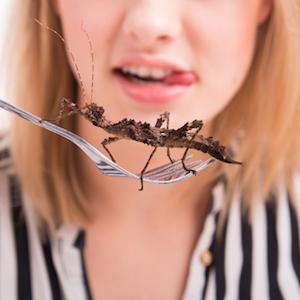As a greater number of people enter the middle class around the globe, many will turn away from plant-based diets in favor of meat-based diets. This could be a cause for concern, as meat production requires the input of substantially more resources, such as water and energy. The question of how to feed a growing world in a time when wealth is spreading and personal tastes are changing is the subject of some sustainability research.
Outside of the Western world, insect consumption is common. The Chinese, for instance, will eat just about anything that crawls on six (or more) legs. Centipedes and fried scorpions appear on the menu.
Not only is entomophagy widespread, it is also probably healthier for people and the planet than eating other animals. Compared to raising cows and chickens, insect farming requires less resources and suffers from fewer ethical considerations. Insects are also incredibly nutritious. For instance, house crickets are rich in protein, but contain only about one-third of the fat found in beef. And, as new research indicates, insects can also be a good source of iron.
In food, iron comes in two varieties: Heme iron and non-heme iron. Heme iron (which is found in hemoglobin, the molecule in red blood cells that carries oxygen) is "bioavailable," meaning that it is easily absorbed and utilized by the body. Foods containing heme iron are good dietary sources of iron. On the other hand, iron that is not found in heme cannot be easily used by the body. Therefore, any study that analyzes the bioavailability of iron in food must take this into account.
So, a team of scientists subjected beef and various insects to a simulated digestion by combining them with acid and enzymes. The resulting mixtures were added to human cells, and the amount of ferritin (a protein that stores iron) produced by these cells was measured as a proxy to determine iron absorption.

As shown, buffalo worms have more bioavailable iron than beef. The iron bioavailability in grasshoppers and mealworms was comparable to but slightly less than beef, while crickets were not a particularly good source of dietary iron.
People who survive on plant-based diets, such as Southeast Asians, are susceptible to iron deficiency anemia. Supplementing their diet with a few bugs might be a way to add this vital nutrient, as well as a little variety, to their cuisine.
Source: Gladys O. Latunde-Dada, Wenge Yang, and Mayra Vera Aviles. "In Vitro Iron Availability from Insects and Sirloin Beef." J. Agric. Food Chem. 64 (44): 8420–8424. Published online: 12-October-2016. DOI: 10.1021/acs.jafc.6b03286




